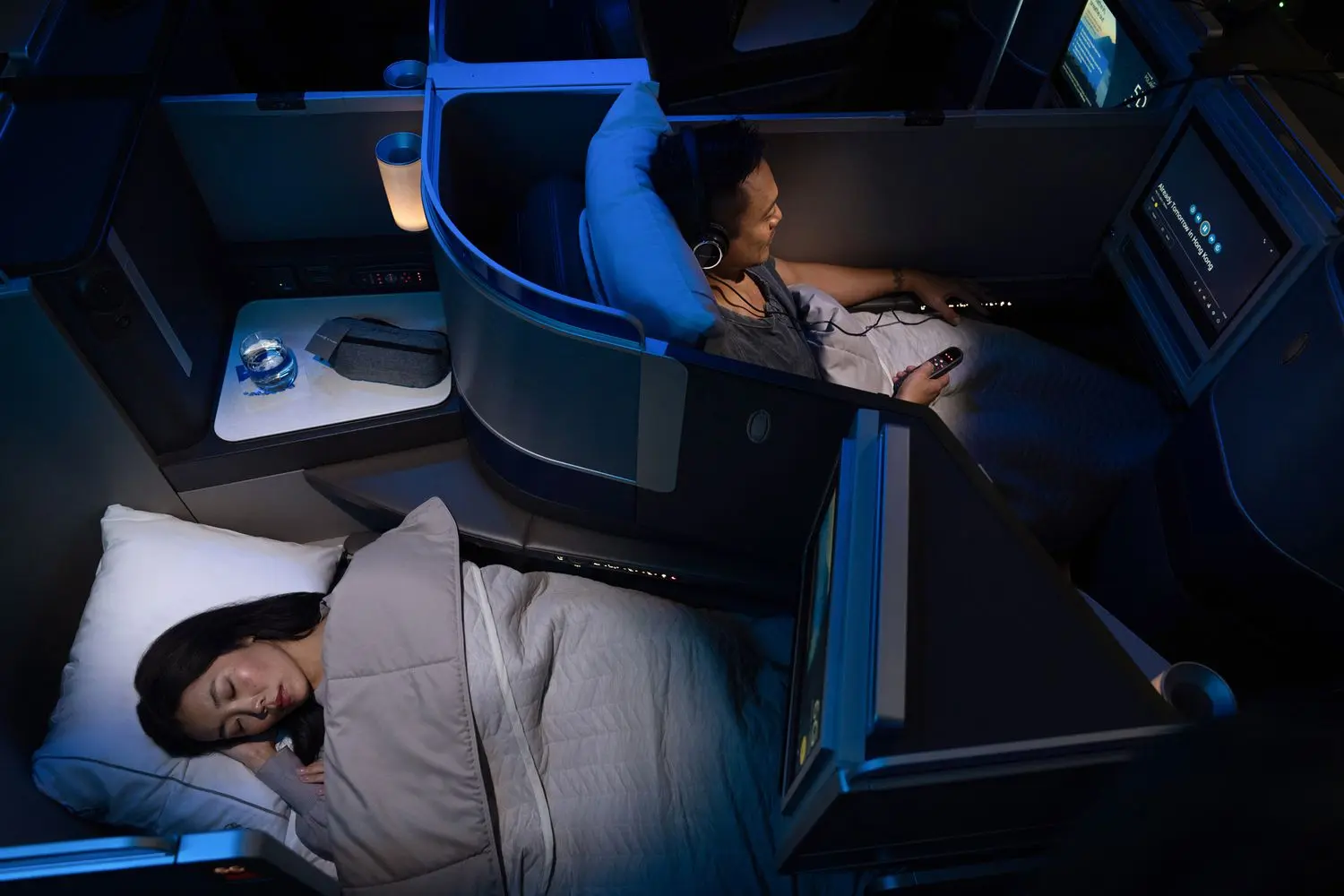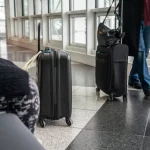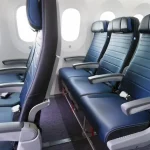Key Takeaways
- Polaris ranges $2,100-$11,000 depending on route and timing, with $6,600-$10,000 typical for prime destinations.
- Book 2-3 months out for best cash prices, avoid summer peak when prices jump 40-60% above baseline.
- Award tickets cost 200,000-400,000 miles but often provide better value than inflated cash prices on popular routes.
- Asia routes ($6,000-$8,000 roundtrip) offer better value per hour than Europe routes ($5,000-$11,000) due to flight length
The Real Cost of United Polaris
After analyzing pricing data across United’s international network and tracking cost patterns for over 18 months, here’s what Polaris actually costs and when those prices make sense. Most travel blogs give you feel-good stories about premium cabins, but miss the brutal economics that determine whether business class delivers value or just empties your wallet.
Our analysis reveals that United’s Polaris pricing follows predictable but complex patterns based on route demand, seasonal factors, and competitive dynamics. Understanding these patterns means the difference between paying $4,000 for excellent value and $11,000 for the same experience on a different date.
The pricing chaos most travelers don’t understand: The same SFO-LHR route can cost $4,400 in February or $9,800 in July – not because the service changes, but because United’s revenue management algorithms exploit demand patterns that most passengers never decode. Community member reports show identical routes varying by 150% based purely on booking timing and seasonal demand.
Our forums discussions reveal traveler frustration with Polaris pricing unpredictability. One user noted finding “Polaris/ANA Business class for $2100 to $2400 to Jakarta” while others report “$4400 each way for United” being overpriced for similar Asian destinations. These variations aren’t random – they reflect route-specific competition and demand patterns.
| Aspect | Details |
| Price Range (Roundtrip) | $2,100 – $11,000; typical prime routes: $6,600 – $10,000 |
| Sweet Spot Pricing | Book 2-3 months ahead for best prices; avoid summer peak (+40-60%) |
| Award Ticket Costs | 150,000 – 400,000 miles roundtrip; better value during peak cash price surges |
| Aircraft Impact | 787-9 Dreamliner = superior comfort with direct aisle access; 777-300ER = more seats but cramped window seats |
| Seat Width | Approx. 22 inches on 777-300ER and slightly narrower (~20.5-21 in) on 787-9 |
| Seat Selection Tips | Avoid bulkhead lavatory/galley rows 6, 8, and 9 (777); odd-numbered seats best for privacy |
| Service Quality | Pacific routes with Asia-trained crews show consistent premium service; Europe variable |
| Premium Plus vs Economy | Premium Plus offers better upgrade priority and comfort; cash upgrade success rate 8-25% |
| Upgrade Costs (PlusPoints) | Economy to Polaris: 40-50 points + cash $400-$1200; Premium Plus to Polaris: 30 + lower cash copay |
| Upgrade Success Rates | Airlines report 8-25% success by route; Asia routes clear 2-3x more often than Europe |
| Booking Strategy | Use miles during peak seasons; cash for off-peak; watch sales 3-4 times a year |
| Airport Lounge Access | Polaris ticket holders receive lounge access; domestic business/Premium Plus do not |
| Additional Notes | Baths shared with economy passengers; power outlets sometimes hard to access |
Route-by-Route Pricing Analysis: What You’ll Actually Pay
Transpacific Routes: The Better Value Proposition
West Coast to Asia pricing patterns:
- SFO/LAX to Tokyo: $6,000-$8,500 roundtrip, varying significantly by season
- SFO to Singapore: $6,600-$9,200 roundtrip on newer 787-9 aircraft
- West Coast to Seoul: $5,800-$7,800 roundtrip with better off-season deals
East Coast to Asia premium:
- Newark/Chicago to Tokyo: $7,200-$9,800 roundtrip due to higher demand
- East Coast to Singapore: $8,000-$11,500 roundtrip, premium for convenience
Value analysis: Asia routes provide 12-16 hours of premium service versus 7-10 hours on Europe routes, making the per-hour cost significantly better despite higher absolute prices.
Transatlantic Routes: Premium Pricing for Shorter Flights
West Coast to Europe:
- SFO to London: $7,800-$11,000 roundtrip, highest demand route
- SFO to Frankfurt: $6,500-$9,200 roundtrip on 747-8 aircraft
- SFO to Munich: $5,800-$8,400 roundtrip seasonal service
East Coast to Europe baseline:
- Newark to London: $5,000-$8,500 roundtrip, varies dramatically by timing
- Newark to Brussels: $4,800-$7,200 roundtrip, better value than London
- Chicago to Frankfurt: $5,200-$7,800 roundtrip, solid mid-market option
The Europe pricing trap: Shorter flight times (7-10 hours) create poor value per hour compared to Asia routes, yet corporate demand keeps prices elevated on popular business destinations.
Premium Route Pricing
New and seasonal routes command premium:
- SFO to Adelaide: Expected $8,000-$10,500 roundtrip when launched December 2025
- Seasonal European routes: 15-25% premium over year-round service
Ultra-long-haul premium: Routes over 15 hours command the highest per-mile pricing but often deliver the best overall value through reduced connection complexity and time savings.
Track real-time Polaris pricing and share booking successes in our United Polaris Pricing forum where members post current deals and seasonal trends.
Seasonal Pricing Patterns: When to Buy vs When to Avoid
Peak Season Premium (June-August)
European summer surge: Prices jump 40-60% above baseline during peak summer travel, with London routes reaching $11,000+ roundtrip during July-August periods.
Asian summer patterns: Less dramatic increases (20-30%) but still significant, particularly on leisure-heavy routes to Tokyo and Seoul.
Corporate travel impact: May-June and September-October show elevated pricing due to business travel patterns, not just leisure demand.
Sweet Spot Seasons
Winter value windows:
- January-March: Best overall pricing with 30-40% discounts from peak rates
- November-early December: Good availability before holiday premium kicks in
- Late August: Brief window between summer peak and fall business travel
Shoulder season opportunities: April-May and September-October offer moderate pricing with better weather than winter travel.
Holiday Pricing Disasters
Thanksgiving week: Prices can double normal rates, particularly on high-demand routes Christmas-New Year period: Premium pricing often 80-120% above baseline rates Spring break surge: March pricing spikes affect leisure-heavy destinations
Booking Timing Strategy: When to Pull the Trigger
The 2-3 Month Sweet Spot
Optimal booking window: Analysis shows best cash prices typically appear 60-90 days before departure, when United releases additional inventory but hasn’t implemented peak pricing algorithms.
Advanced booking risks: Booking 6+ months early often results in higher prices as United hasn’t released sale inventory, while last-minute booking (under 30 days) triggers premium pricing.
Route-specific variations: High-demand routes like SFO-LHR benefit from earlier booking (3-4 months), while lower-demand routes show better prices closer to departure.
Flash Sale Opportunities
United sale patterns: Major sales occur 3-4 times annually, typically offering 20-30% off published Polaris rates on select routes.
Mistake fare potential: Rare but valuable pricing errors occasionally create exceptional deals, particularly on less-monitored routes to Asia.
Competition-driven pricing: When competitors launch new routes or increase frequency, United occasionally responds with temporary pricing reductions.
Miles vs Cash Analysis: When Points Make Sense
Award Pricing Reality Check
Standard award costs:
- Transpacific routes: 200,000-250,000 miles roundtrip
- Transatlantic routes: 150,000-200,000 miles roundtrip
- Peak season surcharges: Additional 20,000-50,000 miles during high-demand periods
Cash equivalent value: At current cash prices, miles often provide 2-4 cents per mile value on international Polaris redemptions, well above typical 1.2-1.5 cent valuations.
Availability challenges: One community member noted paying “200,000 UA miles for a one way Polaris business class from EWR to HND” due to limited award availability. Cash pricing would have been comparable or better.
Strategic Miles Usage
Peak season advantage: Award pricing remains relatively stable while cash prices surge, making miles most valuable during summer European travel and holiday periods.
Last-minute flexibility: Award inventory sometimes opens close to departure when cash prices are prohibitively expensive.
Partner airline options: Air Canada and other Star Alliance partners occasionally offer better award availability than United direct, though with higher fees and taxes.
Hidden Costs and Fee Structure
Taxes and Carrier Charges
Fuel surcharges by destination:
- European routes: $200-$400 in additional fees beyond base price
- Asian routes: $150-$350 depending on specific country taxation
- Partner airline premiums: Codeshare flights often include additional carrier-imposed fees
Award ticket fees: Miles redemptions still require $100-$600 in taxes and fees, reducing the effective value of award bookings.
Change and Cancellation Reality
Flexible fare benefits: Higher-priced Polaris tickets often include free changes and cancellations, while sale fares may carry $300-$500 change fees.
Same-day change limitations: Even Polaris passengers face restrictions on same-day flight changes, particularly during peak travel periods.
Refund processing times: Cash refunds can take 30-60 days, while miles typically return to accounts within 7-10 days.
Upgrade vs Direct Booking Economics
PlusPoints Upgrade Costs
Upgrade pricing structure:
- Economy to Polaris: 40-50 PlusPoints plus cash co-pay of $400-$1,200 depending on route
- Premium Plus to Polaris: 30 PlusPoints plus reduced cash co-pay
- Success rates vary dramatically: 8-25% clearing rates depending on route demand
Real upgrade economics: One traveler noted successful upgrades feeling like “excellent value” while failed upgrade attempts created frustration with wasted PlusPoints and no premium experience.
Cash Upgrade Opportunities
Day-of-departure upgrades: Gate upgrades occasionally available for $800-$2,000 cash, though rare on international routes with high demand.
Advance purchase upgrades: Booking economy with immediate upgrade purchase often costs
10-20% less than direct Polaris booking.
Get real-time upgrade success data and pricing intelligence in our Polaris Upgrade Economics forum where members share upgrade clearing patterns and cost analysis.
When Polaris Pricing Makes Sense vs Overpriced
Value Threshold Analysis
Acceptable pricing scenarios:
- Under $4,000 roundtrip: Excellent value for any international Polaris route
- $4,000-$6,000: Good value for Asia routes, acceptable for prime European destinations
- $6,000-$8,000: Reasonable for peak season or premium routes with good timing
Overpriced territory:
- Above $8,000 for Europe routes: Poor value given 7-10 hour flight times
- Above $10,000 for any route: Approaching first-class pricing without first-class benefits
- Peak summer Europe pricing: Often better to wait for shoulder seasons or consider alternatives
Route-Specific Value Assessment
Best value routes consistently:
- Transpacific routing: Longer flight times justify higher absolute costs
- Off-peak seasonal routes: Munich, seasonal Asian destinations during non-peak periods
- Less popular departure cities: Secondary hub departures often price better than coastal hubs
Routes to avoid at full price:
- SFO-LHR during summer: Notorious for inflated pricing with poor value
- Any route during major holidays: Premium rarely justifies the experience
- Short European routes under 8 hours: Economy plus premium often provides better value
Alternative Strategies When United Pricing Is Excessive
Partner Airline Options
Star Alliance alternatives: Lufthansa, ANA, and Singapore Airlines occasionally offer better business class pricing on similar routes with comparable or superior products.
Codeshare opportunities: United codeshares on partner metal sometimes price differently than United-operated flights on identical routes.
Route Creativity
Alternative departure cities: Flying domestic connections to reach better Polaris pricing from different hubs can provide overall savings despite additional complexity.
Multi-city routing: Breaking long routes into segments occasionally creates pricing inefficiencies that favor consumers.
Positioning flights: Sometimes domestic positioning to reach better international pricing makes economic sense for high-value routes.
The Bottom Line: Polaris Pricing Strategy
United’s Polaris delivers genuine premium value when priced appropriately, typically under $6,000 roundtrip for most routes and under $8,000 for premium Asia destinations. Above these thresholds, alternative strategies or delayed travel often provide better value.
Timing matters more than destination: The same route can provide excellent or terrible value based purely on booking timing, seasonal demand, and competitive factors. Understanding these patterns prevents overpaying for identical experiences.
Miles vs cash decisions require route-specific analysis: Award bookings often provide superior value during peak pricing periods but may not justify hoarding miles during off-peak sales when cash prices drop significantly.
The harsh economic reality: Polaris pricing reflects corporate demand more than consumer value, requiring strategic thinking about when to pay premium prices versus when to seek alternatives or adjust travel timing for better economics.
Share your Polaris booking successes and pricing intelligence in our United Business Class Economics forum where members track deals, analyze pricing patterns, and develop booking strategies.
FAQ: United Polaris Pricing Reality
What’s a reasonable price for United Polaris business class?
Under $6,000 roundtrip represents good value, $6,000-$8,000 is acceptable for prime routes, above $8,000 often overpriced unless peak season Asia travel.
When do Polaris prices drop for the best deals?
January-March and late August typically show lowest pricing, 2-3 months advance booking often optimal for cash fares.
Are Polaris award tickets worth using miles?
Yes during peak seasons when cash prices surge 40-60%, but cash sales during off-peak periods often provide better overall value.
Which routes offer the best Polaris value for money?
Transpacific routes to Asia justify higher prices through longer flight times, while short European routes under 8 hours show poor value per hour.
Should I upgrade to Polaris or book directly?
Direct booking provides certainty, while upgrades offer potential savings with 8-25% success rates depending on route demand and timing.
Related guides on United Polaris:





